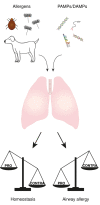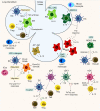The innate immune brakes of the lung
- PMID: 36776895
- PMCID: PMC9915150
- DOI: 10.3389/fimmu.2023.1111298
The innate immune brakes of the lung
Abstract
Respiratory mucosal surfaces are continuously exposed to not only innocuous non-self antigens but also pathogen-associated molecular patterns (PAMPs) originating from environmental or symbiotic microbes. According to either "self/non-self" or "danger" models, this should systematically result in homeostasis breakdown and the development of immune responses directed to inhaled harmless antigens, such as T helper type (Th)2-mediated asthmatic reactions, which is fortunately not the case in most people. This discrepancy implies the existence, in the lung, of regulatory mechanisms that tightly control immune homeostasis. Although such mechanisms have been poorly investigated in comparison to the ones that trigger immune responses, a better understanding of them could be useful in the development of new therapeutic strategies against lung diseases (e.g., asthma). Here, we review current knowledge on innate immune cells that prevent the development of aberrant immune responses in the lung, thereby contributing to mucosal homeostasis.
Keywords: airway allergy; homeostasis; immunoregulation; innate immunity; lung.
Copyright © 2023 Sabatel and Bureau.
Conflict of interest statement
The authors declare that the research was conducted in the absence of any commercial or financial relationships that could be construed as a potential conflict of interest.
Figures


References
-
- Burnet FM. The clonal selection theory of acquired immunity. Nashville: Vanderbilt University Press; (1959). 232 p. Available at: http://www.biodiversitylibrary.org/bibliography/8281.
-
- Burnet SFM. Self and not-self: Cellular immunology, book one. Melbourne University Press; (1969). 346 p.

